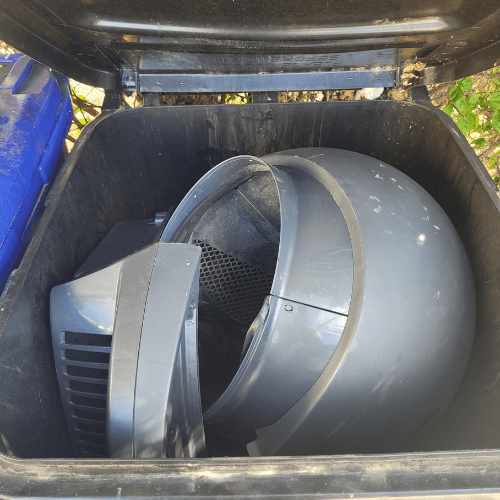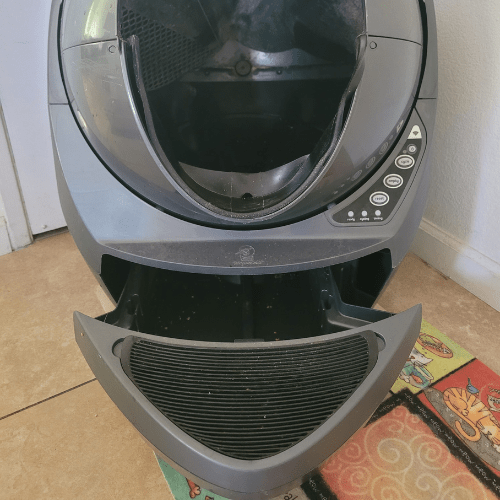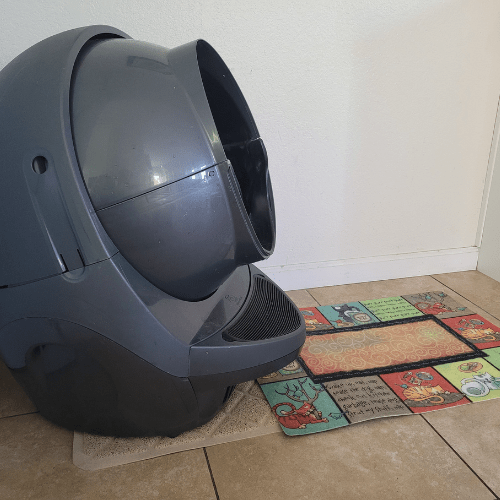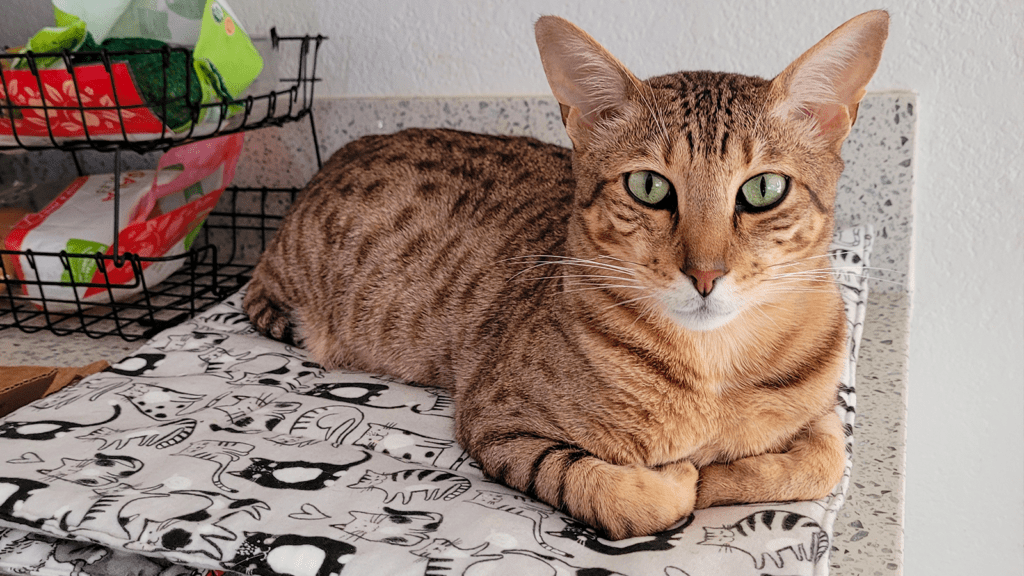
Litter Robot Review
If you’re considering buying a Litter Robot, I’m here to tell you about my experience so that it doesn’t become your experience. I had a Litter Robot 3 Connect and ended up throwing it away after two years. And yes, it still worked. I threw away a fully functional $500 Litter Robot. I have five cats, and here’s my Litter Robot Review.
Pros And Cons Of The Litter Robot
Let’s start with a simple review of the Pros and Cons of the Litter Robot. First, it’s a pretty good automatic litter box. You won’t have to scoop litter daily, and it even works well with multiple cats (I have five). It’s quiet compared to other automatic litter boxes, and it does look pretty cool. Generally speaking, the Litter Robot 3 is a great automatic cat litter box. After all, I did use it for two years.
Now, here are some Cons of the Litter Robot. While you won’t have to scoop litter daily, you will have to change the waste drawer every day or two and generally do some light cleaning each time. Like most automatic litter boxes, this one rotates pretty slowly, especially when your kitty needs to go potty and your Robot is mid-cycle. Slow cycle times are one reason I prefer a traditional litter box, especially in a multi-cat household.



16 Litter Robot Problems
I outlined all the problems I had with the Litter Robot over the years, and here are 16 problems with the Litter Robot automatic litter box.
- Sensor issues. The sensors don’t always work, especially when they are dirty. That means that a cat will be able to use the Litter Robot while it’s mid-motion, which isn’t supposed to happen.
- Globe Rotates slowly. If your cat has to go, it might have to wait! While this is a problem with all automatic litter boxes, the Litter Robot isn’t any different. A slow cleaning cycle is a major con for automatic litter boxes compared to a standard litter box, especially for a multiple-cat space.
- Mold. The many interior crevices and containers make this litter box prime breeding for mold. Even if you regularly deep clean and empty the waste drawer daily, you’re gonna have mold. Mold can impact small animals and a cat’s health much more quickly than humans. Here are some symptoms and concerns of mold and your pets. If possible, keep your litter boxes near open air to help with moisture and odor control.
- Poor front-step design. A few of my cats have unique potty techniques. We found that the small front-step design wasn’t very functional. We placed an extra box in the front to make it easier for the cats to get in and maneuver around while they did their business.
- Poor litter bin design. I haven’t seen an automatic litter box that doesn’t have faulty litter tray designs. I’d say only 90% of the litter makes it conveniently into the disposal bag, which means the remaining 10% will need to be cleaned out.
- It’s plastic and rubber. By the time I threw it away, there were cat scratch marks on the rubber liner. That means that bacteria can get into the rubber liner, and small pieces of rubber come up when your kitty scratches it.
- Deep cleaning challenges. It’s pretty difficult to clean that thing. You really have to take it apart and have space to wash it. You can get by wiping the globe’s interior from time to time, but the interior collects soiled litter, which means a deep cleaning process is often needed.
- Daily cleaning challenges. This comes back to the mold issue and the poor litter bin design. You can wipe the night light and sensor or wipe down the interior of the globe, which helps. Empty the litter twice a week or when the drawer is full, and refresh it with clean litter.
- Ears get litter dust. The Litter Robot rotates 360 degrees which means every part of the egg gets covered in litter. If your cat spends time in the litter box digging or burying, it’s likely going to get extra litter dust on it from brushing against the interior of the globe.
- I never used the app. While this isn’t really a feature bug, if you plan to be super techy with your wifi enabled litter robot iii cat app, I found that the app didn’t provide as much value as I hoped. The app comes with a cat owner manual that explains the settings, such as sleep mode and the one year warranty information.
- It can error, leaving it inoperable. That’s right, the entire thing can error and stop working at different stages. I’ve had errors mid-cycle and errors preventing me from cycling at all. The globe would be left upside down and only rotates back and resets after several hours of unplugging it and replugging it. This was the most frustrating issue I experienced described in this litter robot review.
- Litter choices. I used World’s Best Cat Litter for years until I realized my mistake. The closed litter waste bin and crevices within the Litter Robot were collecting moisture and mold. I began trying different litter to find one that was dry, which led me to a few of the following issues. You need a fast clumping litter because it cycles shortly after the cat uses it. If you use a regular litter like Tidy Cats, you might need to incorporate a portion of fast-clumping litter or wood-based to dry it out and prevent moisture buildup.
- Smell. You may get a smell from your litter during the sifting process, and you can definitely get odors from the lack of cleaning. The carbon filter in the waste drawer helps, and there was space to add additional carbon filters. Changing the waste drawer garbage bag often and refilling the globe with fresh new litter can help, but sometimes, the litter you choose simply reacts poorly to the rubber liner and causes a smell.
- Even the best litter can stick. Even dry litter can stick to the rubber mat. World’s Best Cat Litter didn’t stick, but Swheat Scoop did, so I added Okocat wood to the mix to help with the sticking.
- A cat with medical issues. My cats have put the Litter Robot 3 through the wringer over the years. One kitty battled with chronic UTI flare-ups, which caused him to frequent the litter box dozens of times an hour. There were times when the Litter Robot was helpful in keeping the litter scooped, and there were times when the slow movement and sensor issues caused problems. If your cat often has medical issues, the Litter Robot probably isn’t for you.
- It’s fairly large. While the unit footprint is 24.25″ x 27″, which is about the same size as a regular litter box, the height and front space needed make it much more cumbersome.
How Often Do You Need To Clean The Litter Robot 3?
You’ll want to take the Litter Robot apart and deep clean it every month or two. If you let it go longer than that, you’re really risking unsafe and unsanitary conditions. It’s also crucial to clean the litter bin every time you empty it and to occasionally wipe down the interior with a disinfectant.
You’ll want to empty the cat litter bin every other day, regardless of how many cats you have. It starts to get stinky and funky after a few days. Unless it’s the main litter box, the litter bin doesn’t need to be emptied daily.
How Does The Litter Robot 3 Connect Compare To Other Self-Cleaning Litter Boxes
I also have a LitterMaid Multi-Cat Self-Cleaning litter box and compared it to the Litter Robot 3 Connect for this automatic litter box review. Honestly, I found that each one had Pros and Cons, and between the two, one is about $400 less expensive. If you don’t want the expensive price tag, you can definitely save money and still get the convenience of an automatic litter box by going with a cheaper brand. Litter Robots are good, but they aren’t without their flaws, and some cats don’t like using the Litter Robot due to the enclosed globe design.
I found the main drawback of the LitterMaid to be that litter would clump on the cleaning comb, and I would occasionally need to scrape it off with the scoop. The motion sensor and automatic cleaning cycle had the same problems as the robot.
Pros and Cons of A Self Cleaning Litter Box
The Pros of a self-cleaning litter box, better known as an automatic litter box, are that you no longer need to scoop the litter box. Many of them also have a litter drawer, which you only need to empty a few times a week. Convenience is definitely the benefit of the automatic litter box compared to a regular litter box.
The Cons of a self-cleaning litter box are that they are slow, harder to clean, occasionally error, and, of course, the price. If you have more than two cats, automatic litter boxes don’t work as well because multiple cats will use them more often, which can impact clumping or interrupt the rotation.
I think the best situation for an automatic litter box is in two cat households and paired with a regular litter box. Self-cleaning litter boxes are convenient and usually worth the price, but you should also be prepared to maintain a normal litter box.
Is The Litter Robot Worth It?
In the right situation, the Litter Robot would make a great litter box. For someone who has challenges with daily scooping, has a cat that is regular with the litter box, and is able to clean it frequently, the Litter Robot would be an excellent choice. You’ll still have to deal with finding the right litter that won’t mold or smell, and you might still encounter sensor issues that cause problems. You can also save a bunch of money and get a self-cleaning litter box that isn’t quite as fancy.
For me, the dealbreaker was the mold and the potential for health risks, which is why I wrote this review. We’re completely off self-cleaning and plastic litter boxes, and we’re now using hygienic and easy-to-clean stainless steel litter boxes. And guess what? I tested them all as I phased them out, and the stainless steel litter box was paws-down the cat’s favorite! Cat and human approved.
About the Author: Justin Ruffier
My journey with TNR began in the canyon behind my house. A few kittens were playing in the dandelions, and I began to name them. Then, one day, they showed up with ear tips. I wasn’t sure what to think, so I began researching. I learned that TNR was about helping community cats, and I began to find ways to help others in my community. I’m a cat advocate, marketer, and fundraising specialist, and I want to help all outdoor cats find safe indoor homes or have safe outdoor communities.




